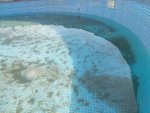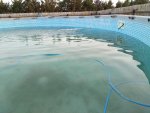My Clack valve operates on a demand initiated regeneration, which is just a fancy way of saying that it measures flow rate and volume through the softener and then regenerates when you’ve reached the set point volume (max capacity - reserve capacity). I have a button I can push on my Clack valve that tells me the number of gallons left before regeneration starts. I noticed it ran yesterday when I went out in the morning so mine does not wait until the off hours (2am) to regen. I think that’s an option one can set but it’s buried in a service menu that the end-customer isn’t given access to (although I was told I could have access to the valve configuration menu if I asked. They just don’t want customers messing up the valve settings). So it looks like I’m getting about 6 days between regen cycles which is about what I expected given the large family I have. I can also manually regen the unit if I want to.
My unit uses 25 gallons of water per regen cycle so even if it did 8 regens per month, that still would be just 200 gallons of water per month extra which is nothing compared to my other uses. My salt tank holds 200lbs of salt which should last several months based on regen capacity. I get 50 lbs bags delivered from the softener company at $7.50/bag. Lowes/HD/Ace are all $7.50 for a 40lbs bag.
Dirk, you definitely want to get an idea of your unit’s capacity. The pool can use quite a bit of water during high evaporation periods and you want to make sure it doesn’t run your softener out before a regen cycle. There’s no damage that will occur to the softener if it gets exhausted; all that happens is your water hardness goes up.
As for why softeners aren’t more prevalent - probably a lot of reasons. I have a neighbor who’s a southwest desert native and he thinks it’s “stupid” to waste money and water softening it. To him, it’s a solution to a non-problem. Part of that argument is right - there is no health benefit to softened water. So if all you have to do is keep fixtures clean or deal with calcium scale, meh!, not really a problem. Others believe that softeners use/waste a lot of water and make your water bills go higher. Old softeners with timer based valves certainly use more water than demand-initiated regen but that’s fixed by replacing old softeners. Also, there is added expense - regen water and salt. Maybe it’s not huge for some people but others might consider it an expense not worth paying for.
Talking with the plumber, he mentioned that building a house and adding the softener loop to the plumbing layout typically raises the plumbing costs by about a $1k. So he was a little surprised that someone paid to have the house built with a softener loop but never used it.
I would definitely say that if you are building a pool in Tucson and your house doesn’t have a softener, then it’s worth adding to the build. Calcium is just one of those insidious pool problems that builds up slowly over time. Adding even a $1000 softener is nothing compared to a pool build price tag of $50k or more and it saves the pool owner a lot of headaches.





